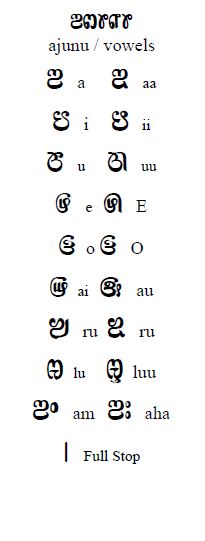
Devanagari, also called Nagari, is a left-to-right abugida (alphasyllabary), based on the ancient Brāhmī script, used in Indian subcontinent. It developed from 1st to 4th century CE, and was in regular use by 7th century CE. The Devanagari script, composed of 47 primary characters including 14 vowels and 33 consonants, is one of the most adopted writing systems in the world, being used for over 120 languages. The ancient Nagari script for Sanskrit had two additional consonantal characters.

Gurmukhī is a Sikh script modified, standardized and used by the second Sikh Guru, Guru Angad (1504–1552). Gurmukhi is used by Sikhs and Punjabi Hindus to write the Punjabi language, a language that is also written in Perso-Arabic Shahmukhi script by Punjabi Muslims.

The Sinhalese script is a writing system used by the Sinhalese people and most Sri Lankans in Sri Lanka and elsewhere to write the Sinhalese language, as well as the liturgical languages Pali and Sanskrit. The Sinhalese Akṣara Mālāva, one of the Brahmic scripts, is a descendant of the ancient Indian Brahmi script and closely related to the South Indian Grantha script and Kadamba alphabet.

The Gujarati script is an abugida, like all Nagari writing systems, and is used to write the Gujarati and Kutchi languages. It is a variant of Devanagari script differentiated by the loss of the characteristic horizontal line running above the letters and by a number of modifications to some characters.
The Brahmic scripts are a family of abugida or alphasyllabary writing systems. They are used throughout the Indian subcontinent, Southeast Asia and parts of East Asia, including Japan in the form of Siddhaṃ. They are descended from the Brahmi script of ancient India, and are used by languages of several language families: Indo-European, Dravidian, Tibeto-Burman, Mongolic, Austroasiatic, Austronesian, and Tai. They were also the source of the dictionary order of Japanese kana.

Malayalam script is a Brahmic script used commonly to write the Malayalam language, which is the principal language of Kerala, India, spoken by 35 million people in the world. Malayalam script is also widely used for writing Sanskrit texts in Kerala. Like many other Indic scripts, it is an alphasyllabary (abugida), a writing system that is partially “alphabetic” and partially syllable-based. The modern Malayalam alphabet has 15 vowel letters, 36 consonant letters, and a few other symbols. The Malayalam script is a Vatteluttu alphabet extended with symbols from the Grantha alphabet to represent Indo-Aryan loanwords. The script is also used to write several minority languages such as Paniya, Betta Kurumba, and Ravula. The Malayalam language itself was historically written in several different scripts.

The Soyombo alphabet is an abugida developed by the monk and scholar Zanabazar in 1686 to write Mongolian. It can also be used to write Tibetan and Sanskrit.

The Tamil script is an abugida script that is used by Tamils and Tamil speakers in India, Sri Lanka, Malaysia, Singapore, Indonesia, and elsewhere to write the Tamil language, as well as to write the liturgical language Sanskrit, using consonants and diacritics not represented in the Tamil alphabet. Certain minority languages such as Saurashtra, Badaga, Irula, and Paniya are also written in the Tamil script.

The Odia script, also known as the Oriya script) is a Brahmic script used to write the Odia language.

The Grantha script is an Indian script that was widely used between the sixth century and the 20th centuries by Tamil and Malayalam speakers in South India, particularly in Tamil Nadu and Kerala, to write Sanskrit and the classical language Manipravalam, and is still in restricted use in traditional Vedic schools. It is a Brahmic script, having evolved from the Tamil-Brahmi. The Malayalam script is a direct descendant of Grantha, as are the Tigalari and Sinhala alphabets.

Saurashtra (ꢱꣃꢬꢵꢰ꣄ꢜ꣄ꢬ) is an Indo-Aryan language spoken primarily by the Saurashtrians of South India who migrated from the Lata region of present-day Gujarat over a millennium ago.

Khojki, or Khojiki, is a script used formerly and almost exclusively by the Khoja community of parts of South Asia such as Sindh. The name "Khojki" is derived from the Persian word khoje, which means "master", or "lord". It was employed primarily to record Isma'ili religious literature as well as literature for a few secret Twelver sects. It is one of the two Landa scripts used for liturgy, the other being the Gurmukhī alphabet, which is associated with Sikhism.

Khudabadi is a script generally used by some Sindhis in India to write the Sindhi language. It is also known as Hathvanki script. Khudabadi is one of the three scripts used for writing the Sindhi language, the other being Perso-Arabic and Devanagari script. It was used by traders and merchants to record their information and rose to importance as the script began to be used to record information kept secret from other groups and kingdoms.
Nandinagari is a Brahmic script derived from Nāgarī script which appeared in the 7th century AD. This script and its variants were used in the central Deccan region and south India, and an abundance of Sanskrit manuscripts in Nandinagari have been discovered but remain untransliterated. Some of the discovered manuscripts of Madhvacharya of the Dvaita Vedanta school of Hinduism are in Nandinagari script.
Tamil All Character Encoding (TACE16) is a 16-bit Unicode-based character encoding scheme for Tamil language.
Multani is a Brahmic script originating in the Multan region of Punjab and in northern Sindh, Pakistan. It was used to write Saraiki language, often considered a dialect of Western Punjabi language. The script was used for routine writing and commercial activities. Multani is one of four Landa scripts whose usage was extended beyond the mercantile domain and formalized for literary activity and printing; the others being Gurmukhi, Khojki, and Khudawadi. Although Multani is now obsolete, it is a historical script in which written and printed records exist. It was also known as Karikki and as Sarai.
Tirukkural has been translated into Saurashtra only once.
Sankhu Ram, also known as S. S. Ram, was an Indian poet of Sourashtra language. He is best known for translating the Tirukkural into Sourashtra.























